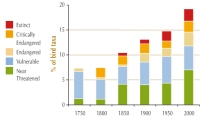
A retrospective study of the changing fortunes of Australian birds since 1750 shows particularly clearly how species became increasingly threatened over time as human impacts in Australia caused mounting pressures on its avifauna. This lead to 26 species or subspecies being driven extinct by the end of the twentieth century.

The history of land use in Australia is well documented. This has allowed a retrospective assessment of the IUCN Red List status of each bird taxon (species and subspecies) at 50-year intervals since 1750 (Brooke et al. 2008). For each taxon in each time period, data on the extent of land clearance, degree of agricultural intensification, presence and abundance of alien invasive species and rate of harvesting were considered in relation to known current habitat requirements, range and ecology and the effects of threatening processes elsewhere in the taxon’s range. The results show how the percentage qualifying as threatened or Near Threatened has increased over time, as mounting pressures caused the status of many taxa to deteriorate. This study is unique in illustrating the steady intensification of human impacts, and the consequent deterioration in status of a region’s avifauna over 250 years. This had resulted in 26 extinctions by the end of the twentieth century and 17.3% of the 1,055 extant taxa being listed in one of the threatened or Near Threatened categories by 2000.
References
Compiled: 2004 Last updated: 2008
Recommended Citation:
BirdLife International (2008)
In Australia, the extinction of birds since 1750 can be linked to human impacts.
Downloaded from https://datazone.birdlife.org/sowb/casestudy/in-australia-the-extinction-of-birds-since-1750-can-be-linked-to-human-impacts on 23/12/2024